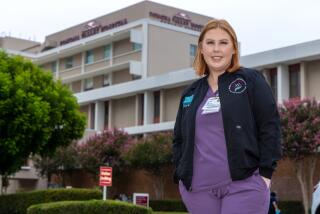Bush accents the positive in New Orleans
Against a backdrop of criticism over the slow pace of the federal rebuilding effort two years after Hurricane Katrina struck, President Bush marked the storm’s anniversary Wednesday with an optimistic message.
“This town is coming back,” he said at a charter school in one of the city’s most flood-ravaged neighborhoods. “This town is better today than it was yesterday, and it’s going to be better tomorrow than it was today.”
The president spent much of the day in the Crescent City and on the Mississippi Gulf Coast, repeating the message of federal support that he has espoused in 14 previous visits to the region, but bringing no new money to spur the recovery.
The Bush administration’s response to Katrina -- the president’s decision to fly over a stricken New Orleans without landing as he returned to Washington from vacation, the chaos of rescue efforts and the botched post-hurricane relief program -- has brought criticism and political controversy.
Two weeks after the storm, Bush stood in Jackson Square in the French Quarter and said, in a speech to the nation, “This great city will rise again.”
On Wednesday, in a quiet recognition of the pressure to turn that message into reality, he said Washington had not forgotten his commitment.
“It’s one thing to come and give a speech in Jackson Square; it’s another thing to keep paying attention to whether or not progress is being made. And I hope people understand we do, we’re still paying attention,” the president said. “We’re still engaged.”
A recent report from the RFK Center for Human Rights and the Institute for Southern Studies estimated that the Bush administration was overstating federal funding for the Gulf Coast rebuilding campaign by as much as 300%, with about $35 billion of an estimated $114 billion actually spent. White House officials said Wednesday that the amount spent was $96 billion.
In an open letter to Bush, New Orleans City Councilwoman Shelley Midura said the funding “has served you well, as your spokesmen often cite it as an indicator of your dedication to our recovery.” But, Midura, who noted that much of the money covered initial relief, added, “it hasn’t served us as well -- it’s not enough, it’s been given grudgingly, and only after our elected officials have had to fight for it.”
Bush also was greeted by an editorial in the Times-Picayune newspaper with a front-page teaser that pleaded: “TREAT US FAIRLY, MR. PRESIDENT.” The newspaper compared federal spending in Louisiana with that in Mississippi and concluded: “In every case, Mississippi ended up with a disproportionate share of aid.”
The disparity between the speed of the recovery in Mississippi, whose Republican governor, Haley Barbour, has close ties to the Bush administration, and in New Orleans and Louisiana, led by Democrats, has been a point of sharp controversy.
The newspaper contended that if Community Development Block Grant funds had been “handed out proportionate to the damage,” Louisiana should have received $22 billion, four times the $5.5 billion that Mississippi received, but it had received just $10.4 billion.
“All Louisiana wants is to be treated fairly,” the editorial said. “But that hasn’t happened.”
Bush made no reference to such controversies on his visit.
He started the day’s public events with a speech in the media room of the Dr. Martin Luther King Jr. Charter School for Science and Technology, dedicated in June and the first public school to open in the storm-devastated Lower 9th Ward. Joseph Recasner, a fourth-grade teacher, said that 15 to 18 feet of water washed through the building during the storm and that people who had sought refuge there were rescued from the second-floor windows.
The president visited the River Garden housing complex, talking with residents in some of the rebuilt houses and spotlighting the federal assistance he said supported the effort. The mixed-income housing project was buffeted by the hurricane’s winds but suffered only minimal water damage.
The presidential motorcade route wound past lingering evidence of destruction: blocks with rebuilt houses but with many more boarded-up houses, some with the spray-paint markings left by searchers looking for the storm’s victims. It took the president over the Industrial Canal, where the new flood wall had “Hindsight” painted in large red letters.
Off his route in the Lower 9th Ward, there was even more evidence: entire blocks deserted and store after store boarded up -- Family Dollar, Walgreens, St. Claude Hardware.
At the center of the federal effort to revive New Orleans is the reconstruction of the levees, which failed to hold back the city’s canals. The Corps of Engineers is scheduled to finish by 2011, said Don Powell, the federal Gulf Coast reconstruction coordinator.
“We fully understand that New Orleans can’t be rebuilt until there’s confidence in the levees,” Bush said.
Contrasting with Bush’s upbeat remarks are the statistics.
The pre-storm population of New Orleans was 455,000; it is now about 274,000. Of the 184,000 people who sought help from the government grant program for rebuilding, 43,000 have been sent checks.
At the start of the year, fewer than 1% of the applicants had received any money from the plan, which is $5 billion short of meeting all the needs.
More than half the city remains in disrepair.
The Lower 9th Ward and the Gentilly neighborhood, both centers of poverty, remain extremely flood-prone.
With tourism at 70% of pre-storm levels, the heart of the New Orleans economy has not fully rebounded.
New Orleans has the highest homicide rate of any American city. Rapes increased 44% in the first half of 2007 compared with a year ago.
The White House said that in the budget request the president would send to Congress for fiscal 2009, he would seek $7.6 billion for work on the levees, and an additional $1.3 billion to improve drainage in New Orleans.
In Mississippi, the president visited Bay St. Louis, which he called the storm’s “ground zero.” A rebuilt bridge served as a backdrop.
“People are worried about insurance here. They’re worried about bureaucracy,” he said at an event with elected officials at Our Lady of the Gulf Community Center, but added that they were most worried they would be forgotten. “We haven’t forgotten, and won’t.”
--
--
On latimes.com
See photo galleries and complete coverage of the second anniversary oHurricane Katrina in New Orleans at latimes.com/katrina
More to Read
Get the L.A. Times Politics newsletter
Deeply reported insights into legislation, politics and policy from Sacramento, Washington and beyond. In your inbox three times per week.
You may occasionally receive promotional content from the Los Angeles Times.






